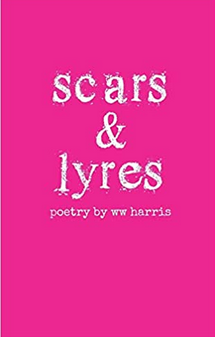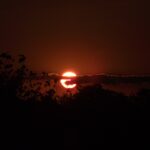by Stephen Guy Mallet

Spoiler alert: “we make lyres / of our scars.” Every symbol is every other symbol on the body’s two-way street of tears; that is to say, tears are tears where /tɪɹz/ are /tɛɹz/ in the space of orphic horizontality in ww harris’s collection of poems scars & lyres. The amount of metonymic math is quite staggering, where any signifier can be any other signifier. So, the axiom of the maths herein appears to be (by my rough estimate): scars are lyres. The ampersand complicates the state of affairs, where the ampersand is a liar and can be a lie in a kisser’s mouth or air in a kissed mouth.
While I tend to argue that the first emotion good poems elicit is jealousy—the reaction seated on one shoulder who whispers you could have written that—a flight suffers whose cockpit is designed with only flight in mind. The reader as a pilot grins for the aerobic qualities of the poems’ shape, whereas the writer as a passenger may find themselves longing for some earthly comfort. Honesty eludes criticism, and for this reason those observing the Confessionalism camp decry a lack of accountability in their craft, of course, but scars & lyres isn’t confessional, so much as it posits a space of exchange between the written and the read. On the one hand—the jealous hand—the images are heavily reliant on the lexicon of canonical poetry. With time being a flat circle in the chain of signification of x equalling y, all citations are self-referential. In the other hand—the appreciative hand—is tied by the umbilical chord of a “blond balloon” to the foreground the only extant colours: Bloody and Canvas-coloured. It follows from the earlier premise that Bloody is Canvas-coloured, and vice versa.
Sounds from a lyre are “whitespace razored”, i.e., “whitespace [whitespace] razored” in the soundspace of the text. While one typically reads text as the antithesis of lacuna—whether in the context of a poem or an erasure poem—the ethos of the poetry herein, and hereon, accrue to become a dissolution of what is read to then become the confluence of visibility to invisibility. Note that this is not the immature act of mimicking synaesthesia. It would be untrue and insufficient to suggest that the art of the lyre is that of invisibility. And I do not mean to suggest that the poem of the lyres and the poem of the scars issue from a source of immaturity: in fact, the reigned lexical breadth promotes horizontality.
Eschewing all things majuscular tends to waft into the reading room in much the same way rock & roll will: {it’ll never die, but our entreatments smack of desperation} [&] {if they’re never to die, why do we so faithfully insist on adjusting our eschatological clocks so?} those aligned to Chaotic Neutral will best appreciate the work at play. Owing typographic debts to the cummings and goings of Edward Estlin is for a poet as common as owing usurious debts to universities, but is inevitable if one hopes to do the thing: it’s less a matter of relevance and more the mere cost of doing business.
Forms of diacope fold and unfold conceptually and lexically: scar within discarded (the latter compellingly appearing as an hapax legomenon) and again within against as the fold holds the emotions in check even as the scars seal the body’s stories—again & against return like the headaches lowercase-g grief inflect us with—the instrument can be said to seal the music within capability; revealing itself as “an origami of shadows”; the tongue in the home of mouth(s); lips before (“lips an open vowel”), during (“with teeth & ripping” and “a lip torn [conjugation of tear] in a kiss”), and after (“like a kiss that won’t stop bleeding”) a kiss; a lisp is the play of enfolding; all seventeen—by my count—usages of “wing”; time in scars & lyres is a flat circle, and we close at the beginning; the final poem, fittingly titled “tears in heaven” indurates the “kiss / across the whitespace of years.” The only redundancy in this flattened space is the ampersand. The maze of an ampersand complicates the augend in the formula of scars equaling lyres. Lacunae contribute to a sense of loss in much the same way restroom graffiti in a dive bar pulls attention to the film of grime in a dive bar’s environs; what if [empty]-space occludes rather than elucidates? There is no margin for error in a marginless collection in an errorless margin.
The end is the beginning when all the landscape looks the same, but it is not, because the landmarks are themselves the empty landscape and the beginning is the end when all the landmarks look the same because the landscape is itself the landmark. This is the body of the text. End is the beginning where there is neither end nor beginning. The beginning causes the end, when the end then causes beginning if the strings of the lyre suture the air into sound, and sound is the pattern of the resonance of the body, which equates to all space if the page is the air is all the space there is. I recommend you read scars & lyres for its tasteful didactic optimistic suturing healing.
Stephen Guy Mallett is the author of the volumes of poems Disparate Logoi, Markov Chainmail, Sunolon, and A Brief History of Scarecrows.



Add your first comment to this post